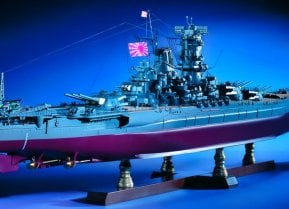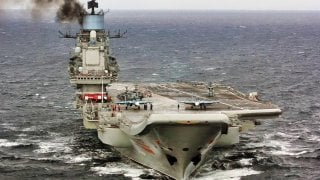Russia Is a Giant Aircraft Carrier Failure for a Reason
Russia's strategic focus on land-based military power and the challenges associated with operating aircraft carriers has led to a limited role for carriers in its naval strategy. The Russian Navy's sole aircraft carrier, Admiral Kuznetsov, has faced numerous issues, casting doubt on its future effectiveness and the necessity of carriers for Russia.
Summary: Russia's strategic focus on land-based military power and the challenges associated with operating aircraft carriers have led to a limited role for carriers in its naval strategy. The Russian Navy's sole aircraft carrier, the Admiral Kuznetsov, has faced numerous issues, casting doubt on its future effectiveness and the necessity of carriers for Russia. Historical attempts to establish a powerful naval presence were thwarted by geographical constraints, technological limitations, and political factors. The geographical location of Russia's naval fleets, coupled with the lack of overseas bases and suitable port facilities, significantly hampers carrier operations. Additionally, the dissolution of the Soviet Union and subsequent industrial and financial challenges have further diminished the likelihood of Russia pursuing a carrier-centric naval force. This strategic reality, combined with evolving military priorities and the practicalities of modern naval warfare, suggests that Russia may continue to deemphasize the role of carriers in its naval doctrine.
Russia Doesn't Have Carriers Because They Don't Need Them
Russia had long been a land-based power and despite efforts during the Soviet era to create a powerful navy, it never was able to rival the United States Navy as a carrier force.
The Russian Navy's one and only aircraft carrier currently remains in port for maintenance and some experts believe she may never sail again – and if she does return to service, her capabilities will still be limited. The Admiral Kuznetsov, which was laid down in the final years of the Soviet era, has been undergoing an accident-plagued refit for years, and that might be enough to convince the Kremlin that Russia doesn't really need a carrier.
Origins of the Russian Navy
The origins of the Russian Navy date back to the fourth century, when the first Slavic flotillas were used to navigate the rivers of Russia, while it has existed as an official force in some form since 1696. The first true iteration of the Russian Navy was established by Peter the Great (Peter I) who famously stated, "A ruler that has but an army has one hand, but he who has a navy has both."
Despite those ambitions, as well as those of Catherine the Great – who established the Black Sea Fleet – Russia was never a true "naval power" and that fact was made abundantly clear centuries later during the Russo-Japanese War in 1905. At that time, the Russian Navy had been considered the third most powerful naval force in the world, but the war proved to be a catastrophe for the Russian military in general and the sea service in particular.
Russia faced a crushing threat from the Japanese in the Battle of Port Arthur, and afterward, warships of the Russian Navy's Baltic Fleet took part in an arduous journey to turn the tide in the war. Instead, it was quickly defeated, serving as a painful reminder that Russia should stick to the land.
Though efforts were made to rebuild the Russian Navy, it was only during the Cold War that Moscow saw the need for a powerful naval force. In fact, the Soviet Union actually had the largest navy in the world – thanks to its force of cruisers and submarines – yet, it never built a warship to truly rival the U.S. Navy's supercarriers.
Soviet Carrier Efforts
As an effort to correct the carrier imbalance in the 1980s, Moscow ordered the construction of a new supercarrier that would be on par with those of its likely adversaries and looked to the canceled Project 1153 Orel (Eagle), which never advanced beyond the blueprint stage.
With a displacement of 85,000 tonnes, the Soviet supercarrier would have been larger than the U.S. Navy's Forrestal-class aircraft carriers, yet still smaller than the contemporary Nimitz-class. The new warship – which was initially named Kremlin before being renamed Ulyanovsk in honor of the birthplace of Vladimir Lenin – was to represent a major advancement over the Soviet Navy's Kuznetsov -class, which utilized a ski-jump to launch aircraft.
It wasn't to be, however.
In the final days of the Soviet era, there was a lack of funding, material, and notably little political support to continue the construction. Even before the official dissolution of the Soviet Union, construction was halted and the vessel's name was struck from the naval register. The remains of the warship were sold for scrapping in 1992 – finally ending the Soviet Navy's only attempt to build a supercarrier.
Location, Location, Location
Since the dissolution of the Soviet Union, there has been talk in the Kremlin to build a fleet of carriers. Yet, it has been Beijing, not Moscow that has made the most progress. There are a few reasons at play.
First and foremost, China now has the largest naval manufacturing capability in the world, while Russia can barely refit its aging warships. There is little reason to believe that even if Russian President Vladimir Putin were to find the funds to build a new carrier that the Russian industry is up to the task.
Another issue that was true in the era of Catherine the Great remains true today. Russia simply lacks the port facilities to base any carriers. The modern Russian Navy consists of four fleets and one flotilla – the Northern Fleet, Baltic Fleet, Black Sea Fleet, Pacific Fleet, and Caspian Flotilla.
The Black Sea Fleet must transit Turkish waters when leaving its home base at Sevastopol, and carriers are specifically banned by international treaty from those waters – which is why some Soviet flattops were designed as aircraft cruisers. Should the treaty be modified, a carrier would still be essentially stuck in the Black Sea in wartime. Ukraine has already shown that warships in those waters are sitting ducks!
The situation isn't much better for the Baltic Fleet, which must pass through Skagerrak – the strait between Denmark and the coasts of Norway and Sweden. Now that Finland has joined NATO and Sweden is all but certain to become a member of the international alliance, the Baltic is essentially a NATO lake. In a war between NATO and Russia, the Kremlin's warships would be prime targets. A carrier in the Baltic Sea would likely be among the first ships to come under attack and sunk.
Only the Northern and Pacific Fleets are provided with direct access to the open ocean. Still, both fleets are headquartered in ports known for extreme winter weather, which is far from ideal for carrier operations. Moreover, the Northern Fleet must pass Norway, while the Pacific Fleet would need to travel close to Alaska.
As is often said about real estate, it is about "location, location, location." Simply put, Russia's locations are terrible for a carrier.
No Foreign Bases
The other part of the equation is that Russia lacks overseas bases, which has been crucial for the U.S. Navy's carrier operations. Russia's naval facility in Tartus, Syria, is not yet capable of hosting the Kuznetsov-class carrier. While Moscow may have goals of having overseas bases, for now at least, it has none.
Carriers that would be stuck in the Baltic or Black Seas, or forced to endure the harsh weather in the Barents Sea or the Russian Far East – and as noted all those locations are situated close to a potential adversaries, which means that a carrier could be caught in port in the event of war or unable to return to port.
All this is why Russia never did – and likely never will – go carrier crazy.
Author Experience and Expertise: Peter Suciu
Peter Suciu is a Michigan-based writer. He has contributed to more than four dozen magazines, newspapers, and websites with over 3,200 published pieces over a twenty-year career in journalism. He regularly writes about military hardware, firearms history, cybersecurity, politics, and international affairs. Peter is also a Contributing Writer for Forbes and Clearance Jobs. You can follow him on Twitter: @PeterSuciu. You can email the author: [email protected].
Image Credit: Russian State Media/Russian Government.


